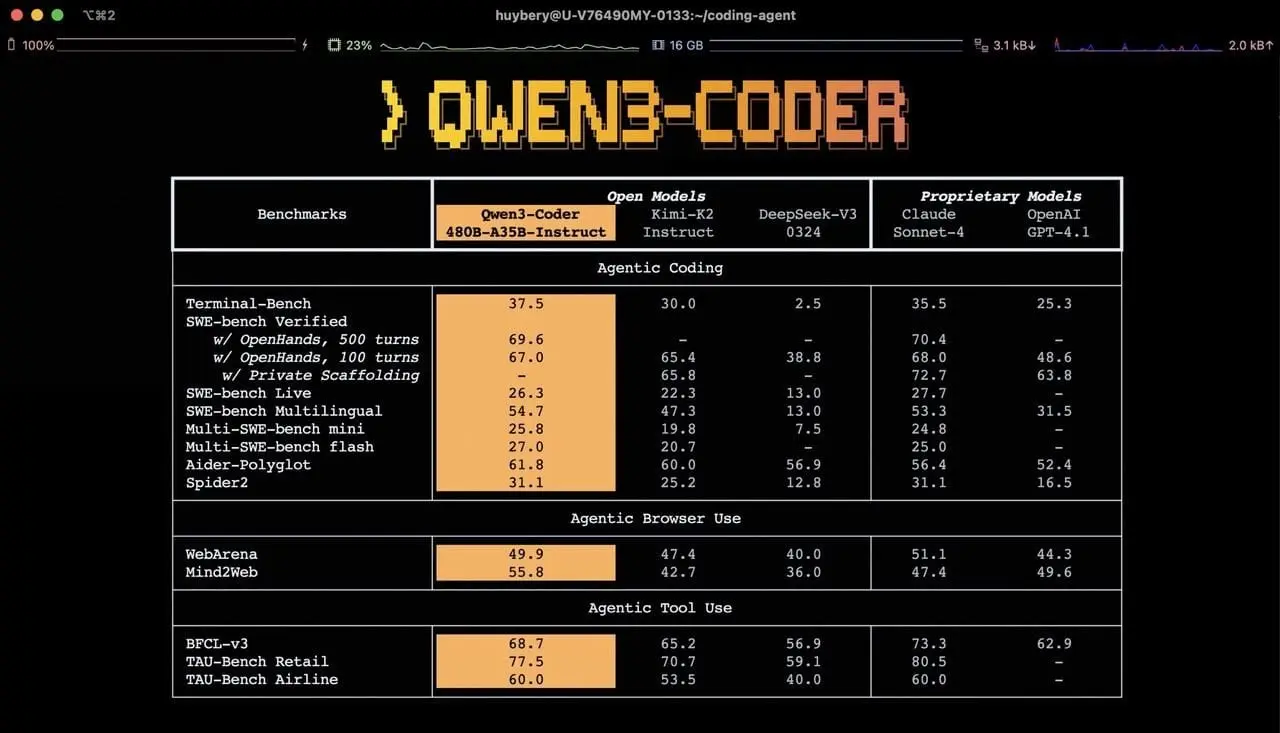Alibaba Unveils Qwen3-Coder: A Groundbreaking Open-Source AI Model for Software Development
9 Sources
9 Sources
[1]
Alibaba launches open-source AI coding model, touted as its most advanced to date
BEIJING, July 23 (Reuters) - Alibaba Group announced on Wednesday the launch of Qwen3-Coder, an open-source artificial intelligence model for software development that the Chinese e-commerce giant described as its most advanced coding tool to date. The launch comes amid intensifying competition among Chinese technology companies in the global AI development race, with firms on both sides of the Pacific releasing increasingly sophisticated models. Qwen3-Coder is designed for software development tasks such as code generation and managing complex coding workflows, Alibaba said in a statement. The company positioned the model as particularly strong in "agentic AI coding tasks" - automated processes where AI systems can work independently on programming challenges. According to performance data released by Alibaba, Qwen3-Coder outperformed domestic competitors, including models from DeepSeek and Moonshot AI's K2 in key coding capabilities. The company also claimed its model matched the performance of leading U.S. models, including Anthropic's Claude and OpenAI's GPT-4 in certain areas. Reporting by Liam Mo and Brenda Goh; Editing by Himani Sarkar and Saad Sayeed Our Standards: The Thomson Reuters Trust Principles., opens new tab
[2]
Alibaba Launches Open Source Model Qwen3-Coder, Surpasses DeepSeek and K2 | AIM
The launch aims to strengthen the company's position in the global AI landscape by showcasing improved functionality for coding tasks from Gemini Code. Alibaba Group announced on Wednesday the launch of Qwen3-Coder, an open-source AI model for software development, claiming it to be its most advanced coding tool to date. The launch comes amid intensifying competition among Chinese technology companies in the global AI development race, with firms on both sides of the Pacific releasing increasingly sophisticated models. Forked from Gemini Code, Qwen Code has been adapted with customised prompts and function calling protocols to unleash the full capabilities of Qwen3-Coder on agentic coding tasks. Qwen3-Coder works seamlessly with the community's best developer tools. "As a foundation model, we hope it can be used anywhere across the digital world, Agentic Coding in the World," Alibaba said in a statement. To address scaling challenges, the company has developed a system that runs 20,000 independent environments in parallel on Alibaba Cloud. This enables Qwen3-Coder to achieve state-of-the-art performance on SWE-Bench Verified without requiring test-time scaling. Based on performance data published by Alibaba, Qwen3-Coder surpassed domestic rivals, including models from DeepSeek and K2 by Moonshot AI, in essential coding abilities. The company also asserted that its model performed on par with top US models, such as Anthropic's Claude and OpenAI's GPT-4, in specific areas. "Unlike the prevailing focus on competitive-level code generation in the community, we believe all code tasks are naturally well-suited for execution-driven large-scale reinforcement learning. That's why we scaled up Code RL training on a broader set of real-world coding tasks," the company said. By automatically increasing the variety of coding task test cases, Alibaba developed high-quality training instances, effectively harnessing the full potential of reinforcement learning. The company claims that this method has improved code execution success rates and fostered exploration of challenging, easily verifiable tasks as promising opportunities in large-scale reinforcement learning.
[3]
Alibaba's Qwen3-Coder Shows Why China's Open Models Can't Be Ignored Anymore | AIM
Chinese e-commerce giant Alibaba's latest release, Qwen3-Coder, strengthens the case that open-source models are now capable of matching proprietary AI systems, at least when it comes to software engineering tasks. Featuring a 480B-parameter Mixture-of-Experts design and support for extended context windows, the model aims to tackle long-horizon agentic tasks that require planning, tool use and iterative feedback. Alibaba has also released an open agentic CLI tool, Qwen Code, to showcase how the model performs in practice. The model also leads open-source performance on tasks like agentic tool use and browser automation, hinting at broader ambitions beyond pure code generation. Across coding, tool use and browser automation, Qwen3-Coder doesn't just close the gap with closed models like Claude 4 Sonnet; it often matches them. On the SWE-bench Verified benchmark, Qwen3-Coder clocks 67% accuracy, which rises to 69.6% with extended multi-turn interactions. That's just below Claude 4 Sonnet's 70.4%, but well ahead of GPT-4.1 at 54.6% and Gemini 2.5 Pro at 49.0%. Its long-context support, with native capacity of 256k tokens, expandable to 1 million tokens; large-scale RL training and custom agent tooling like Qwen Code position it as a serious player in developer workflows -- one that's not just open, but optimised. Qwen3-Coder now leads all open-source models on the Artificial Analysis Intelligence Index with a score of 62, nearly on par with Claude 3.7 Sonnet (62.3), as highlighted by Cline, an autonomous coding agent, on X. It outpaces DeepSeek, Kimi K2 and even closed models like GPT-3.5, reflecting its broad competence across reasoning, coding and long-context benchmarks. Its benchmark dominance stretches further. In tasks like agentic browser use, where it scores 49.9% on WebArena, or real-world tool use with 77.5% on TAU-Bench Retail, Qwen3-Coder often leads the open pack and, occasionally, outperforms everyone. The launch has not gone unnoticed by the developer community. Qwen3-Coder surpassed Kimi-K2 in less than two weeks since its debut. "Despite a significant initial lead, open source models are catching up to closed source and seem to be reaching escape velocity," said Cline, the autonomous coding agent on X. Others were more direct in their praise. "It can write code better than most programmers," Lukasz Olejnik, an assistant professor at SGH Warsaw School of Economics, said. He noted that Qwen3-Coder supports 358 programming languages and understands entire large-scale projects, adding, "Most importantly, it's completely free and open source...Meanwhile, OpenAI was expected to release an open-source model, but that hasn't quite happened." That sentiment -- a mix of admiration and gentle prodding -- has echoed across technical circles. With Claude, Gemini and GPT-4 still largely locked down, Qwen3-Coder has become an unlikely rallying point for the open community. There's little doubt that Qwen3-Coder has tilted the field. In the Artificial Intelligence Index, it now leads all open models with an index score of 62, just behind Claude 3.7 and Claude Opus 4 and comfortably ahead of GPT-3.5. For an open source model, that is noteworthy. Meanwhile, OpenAI's much-awaited open-weights model, originally due in June, is delayed. In the meantime, however, Alibaba has already shipped. On July 23, the White House shared America's AI Action Plan, in which it weighed in on encouraging open-source and open-weight AI models. It mentioned that these models benefit commercial and government adoption of AI because many businesses and governments have sensitive data that they cannot send to closed model vendors. Furthermore, the US government mentioned that the models are essential for academic research, which often relies on access to the weights and training data of a model to perform scientifically rigorous experiments. "We need to ensure America has leading open models founded on American values. Open-source and open-weight models could become global standards in some areas of business and in academic research worldwide," the action plan paper read. "While the decision of whether and how to release an open or closed model is fundamentally up to the developer, the Federal government should create a supportive environment for open models," it added. For now, it seems like Qwen and China are setting the pace for open-source coding, not GPT and the United States.
[4]
Qwen's new AI is a fully autonomous coding agent
Qwen has released Qwen3-Coder-480B-A3.5B-Instruct, an open agentic code model, to enhance software development efficiency and accuracy by integrating advanced algorithms and a vast knowledge base. The Qwen3-Coder-480B-A3.5B-Instruct model represents an advancement in AI-driven coding assistance. It is specifically engineered to improve the effectiveness and precision of software development workflows. This model incorporates sophisticated algorithms and draws upon an extensive knowledge base, enabling it to manage intricate coding assignments with considerable skill. Its design allows it to autonomously analyze, generate, and debug code, which reduces the time and effort typically associated with software creation and maintenance processes. The model is built to accommodate a wide array of programming languages and various development environments. This broad compatibility positions it as a versatile resource for developers working across diverse fields. Its agentic capabilities facilitate independent operation in tasks such as code analysis, generation, and debugging, thereby streamlining development cycles. Qwen3-Coder includes several key features designed to support its function. These include its ability for advanced code generation, which allows it to produce high-quality code snippets and complete programs from natural language descriptions or specifications. Intelligent debugging capabilities enable the model to identify and correct errors within existing codebases, supplying developers with actionable insights and concrete suggestions for resolutions. The model also offers comprehensive language support, covering numerous programming languages such as Python, Java, C++, and JavaScript, which ensures its wide applicability. Furthermore, Qwen3-Coder possesses adaptive learning capabilities, meaning it continuously processes new data and user interactions, thereby refining its performance and accuracy over time. This release by Qwen signifies the company's focus on expanding the applications of artificial intelligence within the software development sector. By equipping developers with this accessible and powerful tool, Qwen intends to stimulate innovation and expedite the delivery of high-quality software solutions.
[5]
Alibaba's Qwen Team Releases New Coding AI Model With Agentic Capabilities
Qwen 3 Code is capable of agentic coding and agentic browser use Alibaba's Qwen team released a new artificial intelligence (AI) coding model on Tuesday. Dubbed Qwen 3 Coder, the model comes with several agentic capabilities including agentic coding, agentic browser-use, and agentic tool-use. The researchers have released only one variant of the model so far, the Qwen3-Coder-480B-A35B-Instruct, which is the most powerful variant in the family. In terms of performance in coding, Alibaba's AI team claims the open-source model is comparable to Anthropic's Claude Sonnet 4 model. The new large language model (LLM) is available to download locally. In a blog post, the researchers detailed the new agentic coding tool. Available in open-source, interested individuals can download the weights from Qwen's Hugging Face listing and GitHub listing. The model is available with a permissive Apache 2.0 licence which allows for both academic and commercial usage. Alongside the model, an open-source command-line tool dubbed Qwen Code is also available for agentic coding. Coming to the model, the Qwen 3 Coder is a mixture-of-expert (MoE) model with 480 billion parameters. Out of that, the model functions with 35 billion active parameters and a context length of 2,56,000 tokens natively. The context window can be expanded to one million tokens using extrapolation methods. The researchers highlighted that the model supports agentic coding, agentic browser-use, and agentic tool-use. The company claims that Qwen 3 Coder achieved state-of-the-art (SOTA) performance among open-source models on the SWE-Bench Verified benchmark. Here, SOTA refers to the highest score which was previously unattainable by any other model. The Qwen team said this score was achieved by creating a scalable system using Alibaba Cloud's infrastructure that could run 20,000 independent environments in parallel. To enable agentic coding, the team has also released the Qwen Code command-line tool. Built from Gemini Code, it has been equipped with custom prompts and function calling protocols. These functionalities allow the AI model to not only write and edit code but also to deploy and execute it in an integrated development environment (IDE). While Qwen Code natively supports Qwen 3 Coder AI model, it can also be integrated with the OpenAI software development kit (SDK) when calling LLMs. On the other hand, the Qwen coding model can also be used with Claude Code. But developers will need to request an API key on Alibaba Cloud Model Studio platform.
[6]
Alibaba QWEN 3 Coder AI Coding Assistant : Smarter, Faster Software Development
What if the future of coding wasn't just faster, but fundamentally smarter? With the debut of QWEN 3 Coder, Alibaba has ignited a seismic shift in the AI industry, challenging the dominance of proprietary giants like GPT-4.1 and Claude Sonnet 4. Boasting a staggering 480 billion parameter architecture and the ability to process up to 1 million tokens in a single context, this open source marvel doesn't just aim to compete -- it's here to lead. Imagine a tool that not only deciphers complex codebases with surgical precision but also adapts to real-world challenges with unmatched versatility. For developers, researchers, and tech enthusiasts, QWEN 3 Coder isn't just another AI model -- it's a glimpse into the future of software engineering. In this deep dive, Wes Roth explores how QWEN 3 Coder is redefining what's possible in AI-driven coding. From its innovative reinforcement learning framework to its practical applications across domains like data analysis and creative development, this model is a testament to the power of open source collaboration. You'll discover how its massive parameter architecture and extended contextual understanding set it apart, and why its performance benchmarks are raising eyebrows across the industry. But beyond the technical specs, QWEN 3 Coder represents something bigger: a widespread access of innovative AI that's reshaping the way we build, create, and innovate. Could this be the moment open source AI finally levels the playing field? QWEN 3 Coder introduces a range of features that distinguish it from other AI coding models. These innovations are designed to enhance its efficiency, adaptability, and real-world utility: QWEN 3 Coder has been rigorously tested against industry benchmarks, and its performance consistently sets new standards in AI-driven coding: Central to QWEN 3 Coder's success is its innovative reinforcement learning framework, specifically designed for coding and software development. This approach prioritizes practical applications over theoretical benchmarks, making sure the model's relevance in real-world scenarios. Key aspects of its training include: To maximize the potential of QWEN 3 Coder, Alibaba has introduced QWEN Code, a command-line tool forked from Google's Gemini Code. This tool is designed to streamline development workflows and enhance the model's usability. Key features include: QWEN 3 Coder is designed to excel in a variety of real-world scenarios, making it a versatile tool for developers, researchers, and industry professionals. Its applications span multiple domains, including: The release of QWEN 3 Coder underscores the fantastic potential of open source AI in reshaping the technology landscape. By narrowing the performance gap between open source and proprietary models, it provide widespread access tos access to advanced AI capabilities, empowering developers and organizations worldwide. Its focus on execution-driven reinforcement learning highlights the growing emphasis on practical, real-world applications, moving beyond theoretical benchmarks to address tangible challenges in software engineering and beyond. QWEN 3 Coder exemplifies the possibilities of open collaboration and innovative research, setting a new standard for AI in coding and software development. Whether you are building complex systems, exploring creative projects, or optimizing workflows, this model offers the tools and capabilities to help you succeed in an increasingly AI-driven world.
[7]
Free Qwen 3 Coder AI Coding Assistant : Insanely Powerful and Open Source
What if coding could be faster, smarter, and more accessible than ever before? Enter Qwen 3 Coder, a new open source large language model (LLM) developed by Alibaba. With a staggering 480 billion parameters and the ability to handle up to 256,000 tokens in a single context, this model isn't just another incremental upgrade -- it's a seismic shift in how developers approach programming. Imagine crafting complex, scalable applications or automating tedious coding tasks with precision, all while using a tool that rivals the best proprietary models out there. And here's the kicker: it's completely free and open source, inviting developers worldwide to innovate without barriers. In this deep dive, World of AI explore why Qwen 3 Coder is more than just a coding assistant -- it's a fantastic option for agentic coding workflows. From its unmatched performance on industry benchmarks to its seamless integration with popular frameworks like p5.js, this model is built to empower developers at every level. Whether you're curious about its ability to handle intricate database queries or eager to see how it automates front-end and back-end development, there's plenty to uncover. By the end, you'll see why Qwen 3 Coder isn't just a tool for today's challenges but a glimpse into the future of programming. Qwen 3 Coder is carefully engineered to handle complex coding tasks with precision and efficiency. Its standout features include: These specifications empower Qwen 3 Coder to address intricate programming tasks while maintaining optimal resource efficiency. Its ability to process vast amounts of data ensures it can handle projects of varying complexity, from small-scale applications to enterprise-level systems. Qwen 3 Coder consistently delivers exceptional results across a range of coding benchmarks, outperforming many open and closed-source models. It excels in tests specifically designed to evaluate coding capabilities, such as: In these benchmarks, Qwen 3 Coder rivals leading models like Claude Sonnet 4 and DeepS V3, solidifying its position as a top-tier solution for agentic coding. Its consistent performance across diverse testing scenarios underscores its reliability and versatility. Qwen 3 Coder is equipped with a suite of tools designed to enhance the developer experience and streamline workflows. These tools include: These features empower developers to fine-tune the model's outputs, making sure adaptability across a wide range of projects. By providing tools that prioritize customization and ease of use, Qwen 3 Coder enhances productivity and reduces the time required for complex coding tasks. Qwen 3 Coder is designed to generate high-quality code for both front-end and back-end development. Its versatility makes it suitable for a wide range of applications, including: By automating complex coding tasks, Qwen 3 Coder significantly reduces development time while maintaining precision and quality. Its ability to handle diverse programming languages and frameworks ensures it can meet the needs of developers across various industries. Qwen 3 Coder is freely available through multiple channels, making sure accessibility for developers worldwide. Key access points include: The open source nature of Qwen 3 Coder promotes transparency and encourages community contributions. Developers can access the latest updates, report issues, or contribute to the model's ongoing development through its GitHub repository. This collaborative approach fosters innovation and ensures the model remains at the forefront of coding technology. Qwen 3 Coder is designed to meet the diverse needs of developers, whether working on small-scale projects or enterprise-level applications. Its ability to generate creative, technically sound code makes it an invaluable tool for: From ideation to deployment, Qwen 3 Coder provides a comprehensive solution for developers aiming to optimize their processes. Its versatility and performance make it a valuable asset for tackling a wide range of programming challenges, from simple scripts to complex systems. Qwen 3 Coder represents a significant leap forward in open source coding models. With its powerful specifications, exceptional performance across benchmarks, and developer-friendly tools, it enables programmers to achieve more in less time. By combining innovative technology with accessibility, Alibaba has set a new standard for agentic coding solutions. Qwen 3 Coder is not just a tool -- it is a resource that equips developers to navigate the evolving landscape of programming with confidence and efficiency.
[8]
New QWEN 3 Coder : Did the Benchmark's Lie?
What if the future of coding wasn't just about writing better code, but about rethinking how code is created altogether? The QWEN 3 Coder, a new open-weight AI model, promises to do just that. With its staggering 480 billion parameters and a token context window that scales up to 1 million, this model is designed to tackle coding challenges at a scale and precision that few others can match. Yet, as with any innovation, it doesn't come without its complexities. While the QWEN 3 Coder excels in practical applications like UI design and automation, it grapples with reasoning-heavy tasks, raising questions about the balance between capability and specialization in AI-driven coding tools. This guide by Prompt Engineering provides more insights into the capabilities, challenges, and future potential of the QWEN 3 Coder, offering an in-depth exploration of what makes it both a powerful asset and a work in progress. From its advanced training methodologies to its open source accessibility, readers will uncover how this model is reshaping the coding landscape while also confronting key limitations like benchmark reproducibility and reasoning inefficiencies. Whether you're a developer seeking to streamline workflows or a researcher curious about the next frontier in AI, the QWEN 3 Coder offers a fascinating glimpse into the evolving relationship between humans and intelligent coding agents. The QWEN 3 Coder is engineered with scalability and high performance in mind, incorporating advanced specifications that set it apart in the field of AI-driven coding. Key features include: These specifications enable the QWEN 3 Coder to manage intricate, multi-turn tasks and create user interfaces (UIs) with precision. Its scalability and adaptability make it a powerful tool for a wide range of coding applications, from front-end development to automation. The QWEN 3 Coder demonstrates competitive performance on benchmarks such as SweepBench Verified, showcasing capabilities comparable to those of Claude Sonnet 4. Its strengths are particularly evident in practical coding tasks, including: For instance, developers automating repetitive coding tasks or designing UIs can rely on the model for efficient and accurate results. However, its performance diminishes in tasks requiring intricate reasoning, such as solving abstract problems or navigating complex mazes without external tools. This limitation underscores the model's focus on practical applications rather than abstract problem-solving. Here are more detailed guides and articles that you may find helpful on AI coding. The advanced training methodologies employed in the development of the QWEN 3 Coder are central to its capabilities. These include: These training and development strategies ensure that the QWEN 3 Coder is both adaptable and efficient, catering to the diverse needs of developers and researchers. Its ability to integrate with existing ecosystems further enhances its appeal as a versatile coding tool. As an open source model, the QWEN 3 Coder is accessible on platforms such as Hugging Face and Open Router, fostering collaboration and innovation within the AI community. Its open availability encourages developers and researchers to contribute to its growth and refinement. Notable features include: This collaborative approach not only strengthens the model's utility but also promotes its adoption across various coding environments. By encouraging open source contributions, the QWEN 3 Coder benefits from continuous improvement and innovation. The QWEN 3 Coder excels in short-duration reasoning tasks, such as generating concise code snippets or resolving straightforward queries. In these scenarios, it often exceeds expectations, delivering results with speed and accuracy. However, its performance declines during prolonged reasoning tasks, particularly those requiring abstract problem-solving or extended logical deductions. This focus on practical coding applications over abstract reasoning reflects broader trends in AI development, where utility and real-world applicability are prioritized. As developers increasingly seek tools that can address immediate, tangible challenges, models like the QWEN 3 Coder are well-positioned to meet these demands. Despite its many strengths, the QWEN 3 Coder is not without its limitations. Key challenges include: These limitations highlight the need for further optimization and refinement. While the QWEN 3 Coder is a powerful tool for specific applications, it is not yet a comprehensive solution for all coding-related tasks. Addressing these challenges will be crucial for its continued development and adoption. The QWEN 3 Coder stands as a robust and versatile coding model, offering significant potential for practical applications such as code generation, UI creation, and agentic tasks. Its advanced training techniques and open source availability make it a valuable resource for developers and researchers. As the AI community continues to refine and explore this model, it is poised to play a pivotal role in shaping the future of coding and artificial intelligence. By addressing its current limitations and building on its strengths, the QWEN 3 Coder has the potential to become an indispensable tool in the evolving landscape of AI-driven development.
[9]
Qwen 3 Coder Agentic Coder Performance Tested
What if coding wasn't just a skill but a conversation -- one where your tools truly understood your intent and worked alongside you? Enter the Qwen 3 Coder, a new model that's reshaping how developers approach software creation. With a staggering 480 billion parameters and a innovative mixture-of-experts architecture, this innovation promises not just speed, but intelligence. Imagine a tool that can autonomously refactor sprawling codebases, generate SaaS prototypes, or even optimize workflows -- all while you focus on solving the bigger problems. It's not just another coding assistant; it's a redefinition of what's possible in agentic coding. In this exploration, World of AI uncover how the Qwen 3 Coder and its companion, the Qwen Code CLI, are transforming development workflows. From outperforming industry giants like GPT-4.1 to automating repetitive tasks with natural language commands, this duo offers a glimpse into the future of coding. But how does it achieve such efficiency without sacrificing precision? And what does its open source flexibility mean for developers looking to tailor solutions to their unique needs? By the end, you might find yourself rethinking not just how you code, but how you innovate. The Qwen 3 Coder distinguishes itself with its ability to handle agentic coding tasks, tool utilization, and browser-based interactions. It has demonstrated superior performance in industry-standard benchmarks such as SwayBench and Spider Ader, outperforming leading models like Claude Sonnet 4 and OpenAI GPT-4.1. As an open source solution, it not only rivals proprietary models but also offers developers transparency and the flexibility to adapt the model to their specific needs. At the core of the Qwen 3 Coder is its mixture-of-experts architecture, which activates 35 billion parameters during inference to optimize efficiency. This design enables the model to address intricate coding challenges, such as generating complex simulations or refactoring extensive codebases. For instance, the Qwen 3 Coder can autonomously create a SaaS landing page or optimize a large-scale project with minimal user input, significantly reducing the time and effort required for such tasks. By using its advanced architecture, the model enables developers to focus on high-level problem-solving while automating routine processes. This combination of efficiency and adaptability makes it a valuable tool for modern software development. The Qwen Code CLI is a powerful command-line interface tool that unlocks the full potential of the Qwen 3 Coder. By allowing natural language commands, it simplifies tasks such as code optimization, refactoring, and documentation generation. This tool is particularly effective for automating repetitive workflows, allowing developers to focus on more strategic aspects of their projects. Key features of the Qwen Code CLI include: The CLI integrates seamlessly with APIs such as Alibaba's ModelScope and OpenRouter, making sure compatibility with existing development environments. Additionally, it supports customization through a "Qwen.md" configuration file, allowing developers to tailor its functionality to meet specific project requirements. This flexibility ensures that the tool can adapt to a wide range of use cases, from small-scale projects to enterprise-level applications. Designed with developers in mind, the Qwen 3 Coder and its CLI tool are straightforward to set up and integrate into existing workflows. To begin, developers need to have Node.js installed on their systems. Once configured, these tools can handle large codebases, connect to APIs, and provide enhanced functionality for a variety of tasks. The model's open source framework ensures that it remains flexible and adaptable to evolving development needs. Its ability to autonomously create prototypes and simulations further reduces development time, allowing teams to accelerate project timelines without compromising on quality. For example, the Qwen 3 Coder can generate a fully functional prototype or refactor an existing codebase with minimal manual intervention, making sure consistent and high-quality results. By integrating seamlessly into existing workflows, the Qwen 3 Coder enhances productivity and enables developers to achieve their objectives more efficiently. Its technical capabilities make it a versatile tool for addressing a wide range of coding challenges. The Qwen 3 Coder has the potential to transform software development workflows by automating complex tasks and enhancing overall efficiency. Its ability to autonomously manage tasks such as creating prototypes, optimizing code, and generating documentation allows developers to focus on higher-level problem-solving and innovation. In practical applications, the Qwen 3 Coder has been used to: These capabilities make the Qwen 3 Coder an invaluable tool for developers working on diverse projects, from small-scale applications to large enterprise systems. By automating routine processes and enhancing productivity, it ensures consistent results and reduces the time required to complete complex tasks. Whether you are developing a SaaS application, automating testing, or generating detailed documentation, the Qwen 3 Coder provides the tools and functionality needed to achieve your goals efficiently. Its open source design and advanced architecture make it a versatile solution for addressing the challenges of modern software development.
Share
Share
Copy Link
Alibaba launches Qwen3-Coder, an advanced open-source AI model for software development, challenging competitors with its agentic coding capabilities and performance across various benchmarks.
Alibaba Introduces Qwen3-Coder: A New Frontier in AI-Powered Software Development
Alibaba Group has unveiled Qwen3-Coder, an open-source artificial intelligence model designed for software development, marking a significant advancement in the company's AI capabilities
1
. This launch comes amid intensifying competition in the global AI development race, with tech giants on both sides of the Pacific releasing increasingly sophisticated models.
Source: AIM
Advanced Features and Capabilities
Qwen3-Coder boasts a 480B-parameter Mixture-of-Experts design and supports extended context windows, allowing it to handle complex coding tasks with remarkable efficiency
3
. The model's key features include:- Support for 358 programming languages
- Native capacity of 256k tokens, expandable to 1 million tokens
- Advanced code generation and intelligent debugging capabilities
- Adaptive learning for continuous performance improvement
4
Performance and Benchmarks
Alibaba claims that Qwen3-Coder outperforms domestic competitors, including models from DeepSeek and Moonshot AI's K2, in essential coding abilities
2
. The model has also shown impressive results in various benchmarks:- SWE-bench Verified: 67% accuracy, rising to 69.6% with extended multi-turn interactions
- Artificial Analysis Intelligence Index: Score of 62, nearly on par with Claude 3.7 Sonnet
- WebArena (agentic browser use): 49.9%
- TAU-Bench Retail (real-world tool use): 77.5%
3

Source: Geeky Gadgets
Agentic Capabilities and Tools
Qwen3-Coder is designed for agentic AI coding tasks, allowing automated processes where AI systems can work independently on programming challenges
1
. To showcase these capabilities, Alibaba has released an open agentic CLI tool called Qwen Code, which enables the model to perform tasks such as writing, editing, deploying, and executing code in an integrated development environment5
.
Source: Geeky Gadgets
Related Stories
Open-Source Approach and Implications
Qwen3-Coder's release as an open-source model with a permissive Apache 2.0 license allows for both academic and commercial usage
5
. This approach aligns with recent discussions on the importance of open-source and open-weight AI models, as highlighted in the US government's AI Action Plan3
.Industry Impact and Future Prospects
The release of Qwen3-Coder has garnered attention from the developer community, with some experts suggesting that it can write code better than most programmers
3
. As open-source models continue to catch up with closed-source alternatives, Qwen3-Coder's performance and accessibility position it as a significant player in the AI-driven software development landscape.References
Summarized by
Navi
[4]
Related Stories
Recent Highlights
1
Meta acquires Manus for $2 billion, adding revenue-generating AI agents to its platforms
Business and Economy

2
Nvidia locks in $20 billion Groq deal, securing AI chip rival's technology and talent
Business and Economy

3
Geoffrey Hinton warns AI job replacement will accelerate in 2026 as systems gain new capabilities
Technology








